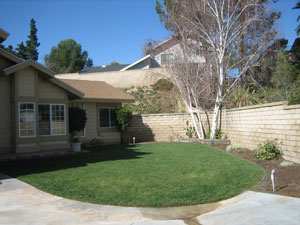Lawn Tree for Interior Zone
 Question from Len:
Question from Len:
Where can I buy a white birch tree? The local nursery trees look unhealthy. Which white birch is best in my area in north Los Angeles county?
Answer from Pat:
The reason the white birch trees in nurseries near you look so bad is because North Los Angeles County is too hot in summer for growing them. You don’t live in an area where they grow easily or well. Hence I am unable to recommend a nursery where you can find a good one.



Thank you for getting back to me. I sent you two photos along with this email. I have had these white birch trees since 1984. I had a dual trunk white birch in the middle of the lawn that died 15 years ago, and had another one at the bottom right of the photo where you can see the old garden light, that died 10 years ago. What do you think of a California Pepper Tree in the middle of the lawn? As I drive around my neighborhood I see beautiful evergreen trees on city property and I think they are pepper trees.
Do you have a tree farm where we can purchase trees or shrubbery?
I strongly advise against planting a California pepper in your lawn. I love them too but suggest you admire them from afar as I do. Instead, I would choose crape myrtle (Lagerstroemia indica.)
I advise you to create a nicely-shaped raised bed in your lawn, placing it in the best position where you can enjoy your tree from house and street. You can find warm brown, reddish or golden-colored (not gray!) rounded concrete “rock” or concrete blocks for building this bed and design it to be kidney shaped instead of square or oblong. Place the outward curved portion of the bed so it points to the right-hand foreground corner of lawn nearest the street (in the photo you sent me) and point the inward curve so it faces your front window. Make the bed 2 or 3 blocks tall, but put in footings first, and leave the bottom open to the soil below. You do not have to remove the lawn beneath the bed—it will rot.
Don’t bury any irrigation lines. Instead, bring the water system up inside the bed and install bubblers to water the bed. Fill the raised bed with good quality top soil and plant your crape myrtle (Lagerstroemia indica) there. Choose your color carefully while the trees are in bloom, but do not choose the white one.
The bark of the tree will provide the lovely bark color you want. Though not pure white, the bark is whitish part of the year and sometimes pink and light brown and the shape of the tree and trunk can be pruned lightly and artistically, so it eventually will be far superior in shape to white birch. All the colors of crape myrtle are good except white, which is mediocre. Landscape architects often choose the white form of this tree because of its disease resistance but there is no emotional “lift” when you see it in bloom. (There are many far-better white flowers on trees than those of white crape myrtle.)
The value of crape myrtle is the “electric” look of its most brilliant flower colors when the tree bursts into bloom in late summer, including light or deep pink, lavender, purple, magenta, red, and coral. This great display will be followed by red hue of leaves in fall (better on some hybrids than on others. ) After this you will enjoy the lovely bark colors in winter with bark that peels off and shows other colors beneath. You will love this tree and it loves heat. Get one of the many delightful hybrids that are mildew resistant. See the lists and descriptions of each in Sunset Western Garden book. You can purchase these trees at any good nursery or tree farm. Build the raised bed this spring or summer and purchase the tree when in bloom so you are sure you love the color of its flowers.
When your existing silver birch finally dies you can replace it with another crape myrtle and eventually have three of them, one in the lawn, one next to the house on the right and one placed approximately where your silver birch is now. Choose the same color, or even three different hues that blend well together.
I cannot recommend a specific nursery for finding this tree. You can find them everywhere when they are in bloom. Just go to a good quality nursery or tree farm. I am not a nursery owner, and I seldom if ever recommend specific nurseries. I am a garden guru, public speaker and author of the most popular, all-inclusive and helpful book for Southern California gardeners, “Pat Welsh’s Southern California Organic Gardening, Month by Month” published by Chronicle Books. (Take a look at a copy at your local book store or find it online.)